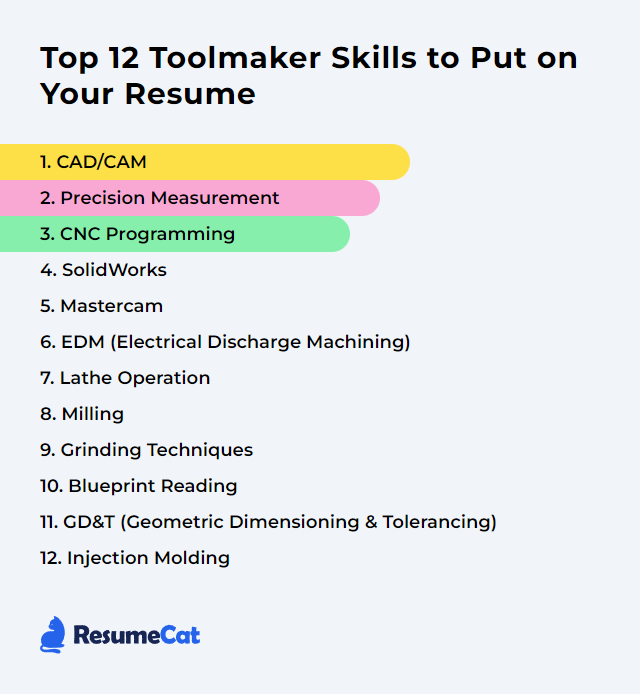Top 12 Toolmaker Skills to Put on Your Resume
In the precision-driven world of toolmaking, showcasing a diverse set of skills on your resume is crucial to standing out in a competitive job market. This article outlines the top 12 toolmaker skills that employers value most, helping you highlight your expertise and secure your next opportunity in the field.
Toolmaker Skills
- CAD/CAM
- Precision Measurement
- CNC Programming
- SolidWorks
- Mastercam
- EDM (Electrical Discharge Machining)
- Lathe Operation
- Milling
- Grinding Techniques
- Blueprint Reading
- GD&T (Geometric Dimensioning and Tolerancing)
- Injection Molding
1. CAD/CAM
CAD/CAM stands for Computer-Aided Design and Computer-Aided Manufacturing. Toolmakers lean on CAD for designing tools, molds, and dies, then hand the baton to CAM to generate machine instructions. That handoff closes the loop from concept to chips on the floor—fewer errors, tighter tolerances, cleaner throughput, and complex geometry made routine.
Why It's Important
CAD/CAM lets a toolmaker design precisely, program accurately, and manufacture repeatably. It trims rework, speeds up cycles, and enables intricate features that would be maddening to do by hand.
How to Improve CAD/CAM Skills
Sharper CAD/CAM means better parts and calmer nights. Try these:
Upgrade software and hardware: Current releases and capable workstations reduce crashes and choppy performance.
Continuous learning: Follow new features and workflows through tutorials, vendor training, and peer groups.
Standardize: Create templates, libraries, and programming checklists. ISO standards for CAD data exchange are useful references.
Simulate first: Use verification and machine simulation to catch gouges, air-cuts, and collisions before metal meets metal.
Tie into planning: Integrate with scheduling, tooling databases, and inventory so design changes ripple cleanly to the floor.
Collaborate: Shared models, version control, and commented toolpaths prevent tribal knowledge from going missing.
Automate the boring: Macros, templates, and feature-based strategies for repetitive features save hours.
Maintain regularly: Keep software patched and workstations healthy. Backups. Drivers. License servers.
Close the loop: Gather operator feedback and metrology results, then refine posts, libraries, and defaults.
How to Display CAD/CAM Skills on Your Resume
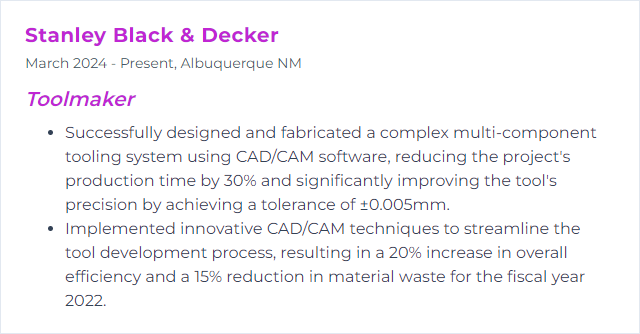
2. Precision Measurement
Precision measurement means using high-accuracy instruments to verify dimensions, angles, and surface conditions so parts meet spec with minimal error. It’s the guardrail for every cut you make.
Why It's Important
Without precise measurement, you’re guessing. With it, parts fit, assemblies run, tools last, and customers stop calling about surprises.
How to Improve Precision Measurement Skills
Calibration: Calibrate gages and instruments on a schedule traceable to national standards such as NIST.
Environment control: Stable temperature, humidity, and cleanliness tame drift and reduce noise in the numbers. ASHRAE guidance can help with climate control practices.
Quality tools: Invest in trusted brands for micrometers, CMMs, and surface gages—Mitutoyo, among others.
Training: Teach proper technique, handling, and interpretation. Organizations like the Precision Machined Products Association (PMPA) and similar industry groups offer helpful education.
Digital workflows: Use digital indicators, CMM software, and SPC to improve repeatability and traceability. Companies such as FARO provide robust measurement solutions.
Care and upkeep: Clean, lubricate, and store instruments properly. Standard references like Machinery’s Handbook remain gold.
How to Display Precision Measurement Skills on Your Resume

3. CNC Programming
CNC programming for a toolmaker creates the instructions machines follow—toolpaths, tools, feeds, speeds, strategies—so complex parts come out clean, accurate, and repeatable.
Why It's Important
It drives accuracy, consistency, and throughput. Program well and scrap evaporates. Program poorly and you fight chatter, broken tools, missed dates.
How to Improve CNC Programming Skills
Master your CAD/CAM: Deep knowledge of advanced strategies, tool libraries, and posts speeds programming and improves results.
Simulate: Use verification and machine simulation tools like VERICUT to catch issues early.
Optimize toolpaths: High-efficiency milling, rest machining, and adaptive clearing reduce cycle time and tool wear.
Stay current: Follow trade publications and communities for new methods and tooling updates.
Think lean: Remove wasted motion. Shorten setups. Group operations intelligently.
Right tooling: High-quality cutters, holders, and balanced assemblies matter. Brands such as Sandvik Coromant set benchmarks.
Refine G-code: Use editors and optimization utilities to streamline programs where it counts.
Feedback loop: Partner with operators. Their notes on chips, heat, and sound are data too.
How to Display CNC Programming Skills on Your Resume

4. SolidWorks
SolidWorks is a CAD platform toolmakers use to model parts, molds, and fixtures in 3D, then analyze and refine before chips fly.
Why It's Important
It accelerates design, simplifies changes, and reveals issues early. Fewer surprises on the machine, more confidence in the mold base or die set.
How to Improve SolidWorks Skills
Lock down the basics: Sketching discipline, robust feature trees, and smart mates prevent headaches later.
Use advanced tools: Mold tools, surfacing, configurations, and weldments pay off in toolmaking workflows.
Simulate: Stress checks, interferences, draft and undercut analysis—catch problems before steel is cut.
Customize: Templates, design tables, macros, and API automation slash repetitive drudgery.
Stay updated: New releases bring performance gains and features worth learning.
Community matters: Forums and user groups trade tips, macros, and clever workarounds.
Certify: Structured training and certifications sharpen skills and signal credibility.
How to Display SolidWorks Skills on Your Resume
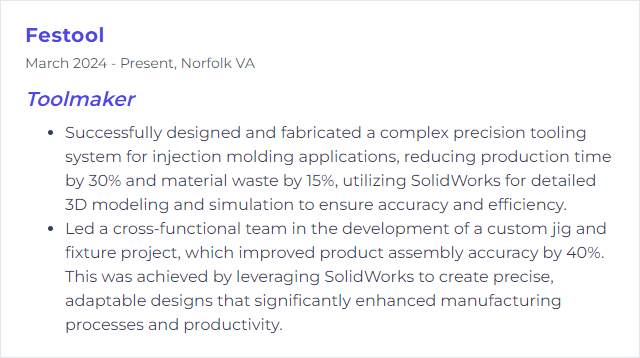
5. Mastercam
Mastercam is CAM software that helps toolmakers program milling, turning, and more, from roughing to finishing, with verification and post-processing baked in.
Why It's Important
It turns clean models into efficient toolpaths, reducing cycle time and improving surface finish while keeping machines safe and busy.
How to Improve Mastercam Skills
Master fundamentals: Planes, chaining, tool libraries, posts—solid foundations speed everything else.
Explore advanced strategies: Dynamic motion, rest machining, and multi-axis paths elevate results.
Customize your workspace: Tailor toolbars, hotkeys, and defaults to your jobs and machines.
Engage the community: Forums like eMastercam surface tricks and practical fixes.
Run real projects: Nothing replaces time on actual parts. Iterate based on finish and inspection data.
Keep current: Updates often bring smarter strategies and better verification.
How to Display Mastercam Skills on Your Resume
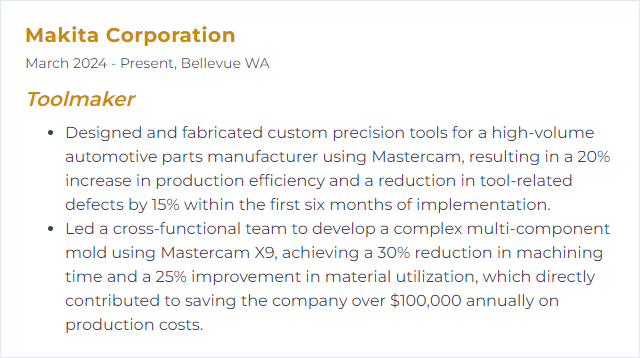
6. EDM (Electrical Discharge Machining)
EDM shapes hard materials and intricate forms by spark erosion between an electrode and workpiece submerged in dielectric fluid. When mills balk, EDM steps in.
Why It's Important
It creates delicate ribs, sharp internal corners, and deep cavities with minimal mechanical stress—core work for molds, dies, and precision tooling.
How to Improve EDM (Electrical Discharge Machining) Skills
Match materials: Choose electrode and workpiece materials for conductivity and thermal stability—graphite, copper, copper-tungsten where appropriate.
Tune parameters: Dial in current, voltage, on/off time, and flushing to hit rate, finish, and accuracy targets.
Dielectric discipline: Proper fluid selection, filtration, and flushing keep debris at bay and stabilize the spark.
Electrode design: Minimize wear, plan offsets, and fixture repeatably for multi-burn jobs.
Maintain machines: Clean tanks, check pumps, square guides, and verify power delivery. Consistency beats heroics.
Smart controls: Use adaptive control and process monitoring where available to steady arc behavior.
Train continuously: Hands-on practice and programs through groups like the National Tooling and Machining Association (NTMA) pay dividends.
How to Display EDM (Electrical Discharge Machining) Skills on Your Resume

7. Lathe Operation
Lathe work spins the part and brings the tool to bear—turning, facing, grooving, threading—to generate the diameters and features your build needs.
Why It's Important
It’s foundational. Precision shafts, bushings, pins, and threaded components demand tight control and proper finishes.
How to Improve Lathe Operation Skills
Maintain the machine: Lubricate ways, check alignment, inspect belts and chucks. A straight machine makes straight parts.
Right tooling: Choose inserts and grades matched to material and operation. Solid, balanced holders reduce chatter.
Cutting conditions: Set speed, feed, and depth to the insert’s sweet spot and the rigidity you actually have.
Workholding: Use appropriate chucks, soft jaws, collets, or fixtures. Concentricity starts at the grip.
Keep edges sharp: Dull tools lie. Regrind or index on schedule to maintain finish and size.
Helpful upgrades: DROs, quick-change toolposts, and, where viable, CNC conversions or modern CNC lathes from makers like Haas boost precision and speed.
Ongoing training: Courses and shop-floor mentoring uncover safer, faster methods.
Quality checks: Measure often with micrometers, bore gages, and indicators. Catch drift early.
How to Display Lathe Operation Skills on Your Resume
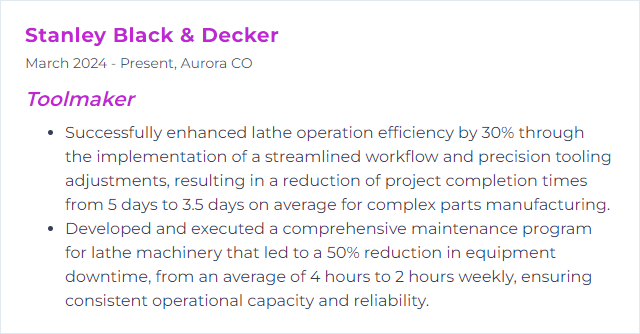
8. Milling
Milling removes material with a rotating cutter to create pockets, slots, holes, contours, and fine surfaces—bread-and-butter work for toolmaking.
Why It's Important
It enables complex geometry with high accuracy and finish quality, forming the backbone of dies, molds, jigs, and fixtures.
How to Improve Milling Skills
Pick the right cutter: Geometry, coating, and substrate should match the material and operation. Carbide reigns for many metals; HSS still has its place.
Dial in parameters: Spindle speed, feed per tooth, axial and radial engagement—set them using toolmaker’s charts, reputable calculators, and cutting data from your supplier.
Smarter toolpaths: High-efficiency milling, trochoidal moves, and rest strategies distribute load and extend tool life.
Coolant strategy: Apply flood, mist, MQL, or through-spindle intelligently. Heat control is finish control.
Machine care: Keep spindles true, gibs snug, and tables clean. Verify tram and squareness regularly.
Rigid toolholding: Quality holders—heat shrink, hydraulic, or precision collets—can be the difference between glassy and gummy.
Keep learning: Follow trusted machining publications and vendors for evolving methods and materials.
How to Display Milling Skills on Your Resume

9. Grinding Techniques
Grinding shapes, sharpens, and refines using abrasives. Surface, cylindrical, and centerless methods deliver geometry and finish you can’t always cut.
Why It's Important
It’s the difference between “close” and “dead-nuts.” Proper grinding ensures accuracy, surface integrity, and tool life.
How to Improve Grinding Techniques Skills
Choose wisely: Match wheel type, grit, grade, and bond to the material and operation.
Dress routinely: Keep the wheel sharp and true. Dressing restores form and opens the structure.
Control parameters: Wheel speed, feed, depth of cut, and dwell—tune to manage heat and achieve finish.
Coolant matters: Flow, concentration, and filtration protect the part and the wheel.
Secure fixturing: Rigid, precise workholding minimizes runout and deflection.
Measure often: Use comparators, surface testers, and micrometers to verify before you go too far.
Safety first: Wheel integrity checks, proper guards, PPE, and adherence to shop safety standards are non-negotiable.
How to Display Grinding Techniques Skills on Your Resume
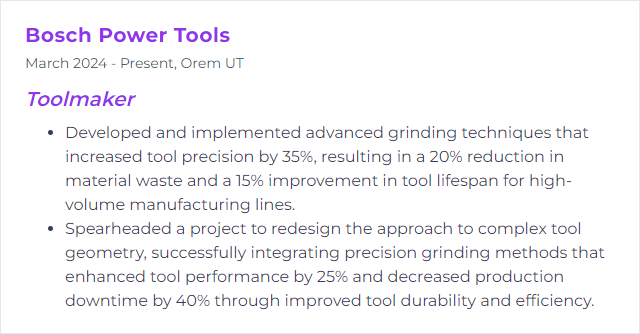
10. Blueprint Reading
Blueprint reading is interpreting drawings—dimensions, symbols, tolerances, finishes—so the tool you build matches the designer’s intent exactly.
Why It's Important
Misread a callout and you miss the mark. Read fluently and you manufacture precisely, on time, without rework.
How to Improve Blueprint Reading Skills
Master fundamentals: Line types, views, sections, notes, and standard symbols.
Learn GD&T: Understanding ASME Y14.5 conventions unlocks design intent and inspection criteria.
Practice: Work through real prints regularly—old jobs, sample parts, training packets.
Leverage CAD: Use CAD to visualize tricky features in 3D and validate interpretation.
Attend workshops: Industry groups and training providers (e.g., Tooling U–SME, NIMS-aligned programs) offer structured courses.
Keep references handy: Texts like “Print Reading for Industry” remain invaluable.
How to Display Blueprint Reading Skills on Your Resume
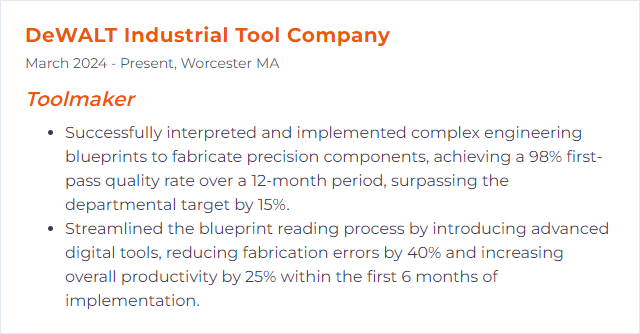
11. GD&T (Geometric Dimensioning and Tolerancing)
GD&T is a symbolic language that defines size, form, orientation, and location requirements. For toolmakers, it clarifies what truly matters functionally—and what must be measured to prove it.
Why It's Important
It reduces ambiguity, improves interchangeability, and aligns design, manufacturing, and inspection on the same target.
How to Improve GD&T (Geometric Dimensioning and Tolerancing) Skills
Start with principles: Feature control frames, datums, material condition modifiers—know them cold.
Apply in CAD: Annotate models and drawings using GD&T, then build and inspect to those callouts.
Use the standard: Study ASME Y14.5. It’s the rulebook.
Take courses: Structured training through reputable providers (including online platforms) accelerates mastery.
Discuss with peers: Forums, shop reviews, and joint print reads surface misunderstandings before they hit the spindle.
How to Display GD&T (Geometric Dimensioning and Tolerancing) Skills on Your Resume
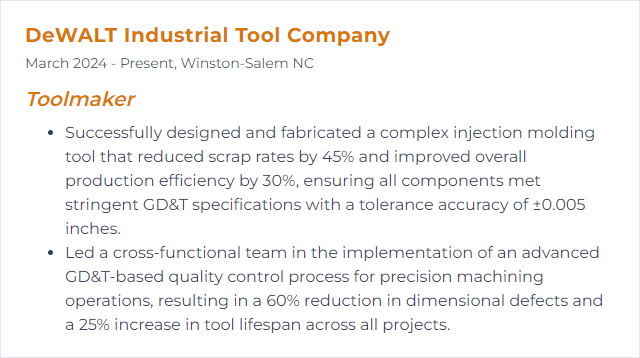
12. Injection Molding
Injection molding forms parts by injecting molten material into a mold, then cooling and ejecting. Toolmakers craft the molds that make it all repeatable.
Why It's Important
It enables high-volume, consistent production of complex parts at compelling unit cost—so long as the mold design and process are dialed in.
How to Improve Injection Molding Skills
Design for flow and cooling: Uniform cooling, proper gates and runners, and smart venting fight warpage and sinks.
Choose the right steel: Match hardness, polishability, and wear resistance to resin and volume. Tool steel selection guides from reputable suppliers help.
Precision machining: Use accurate CNC and EDM methods, then verify critical geometry with metrology.
Surface engineering: Coatings and treatments can reduce wear, improve release, and extend maintenance intervals.
Process control: Monitor pressures, temperatures, fill times, and cooling with sensors and data logging to stabilize cycles.
Maintain religiously: Clean, inspect, and track components. Systems like dedicated mold maintenance logs keep downtime predictable.
How to Display Injection Molding Skills on Your Resume

